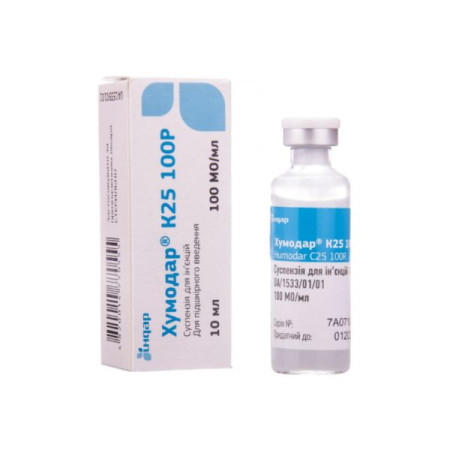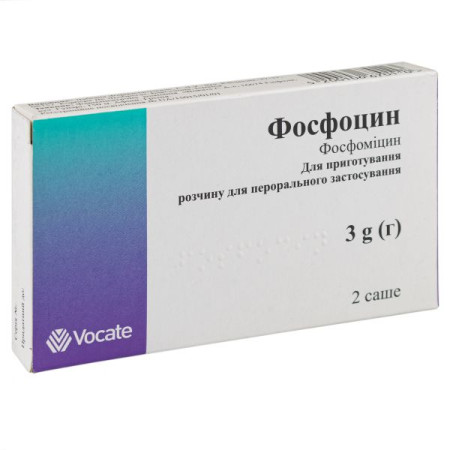Humodar B 100R suspension for injection 100 IU/ml vial 10 ml No. 1

Pharmacological properties
Pharmacodynamics. insulin preparation, identical in structure to human insulin. provides a decrease in blood glucose levels, enhances its absorption by tissues. active ingredient - 100% crystalline protamine insulin.
Pharmacokinetics. Humodar B 100 R is characterized by a slow onset and significant duration of action. The drug begins to act 1 hour after administration, the maximum effect is achieved after 4-6 hours, the duration of action is 12-20 hours. The duration of action of the drug is approximate; it depends on the dose of Humodar B 100 R and the individual characteristics of the patient. Humodar B 100 R can be mixed in any ratio with Humodar R 100 R as prescribed by a doctor.
Indication
Diabetes.
Application
Before first use, determine sensitivity to the drug by intradermal test.
The dose and time of injection are set by the doctor individually depending on the diet, blood glucose level, and the patient's needs. When selecting a dose of Humodar B 100 R for adults, the daily insulin requirement is 0.5-1 IU/kg of body weight.
Humodar B 100 R is administered subcutaneously 45-60 minutes before meals. The injection site should be changed after each injection. Humodar B 100 R should not be administered intravenously!
Cartridge. Before use, mix the cartridge with the drug as follows: shake 10 times between the palms and turn 180 ° 10 times. Before inserting the cartridge into the syringe pen, check the homogeneity of the suspension in it, and if necessary, repeat the procedure again as described above. After mixing, the drug should have the appearance of a homogeneous, cloudy, milky suspension.
Before using the pen, wash your hands and disinfect the rubber membrane of the cartridge. The cartridge is intended for use only in pens. When installing the cartridge in the pen, follow the instructions of the pen manufacturer.
If there are air bubbles in the cartridge, hold the pen with the needle pointed upwards and, tapping the wall of the cartridge, release the bubbles to the surface. Continuing to hold the pen in an upright position, release 2 units of insulin through the needle. Repeat the procedure until the air comes out of the cartridge and a drop of the drug appears at the end of the needle. The presence of very small air bubbles is allowed, but a large number of them can affect the accuracy of the insulin dose during administration.
Before injecting insulin, thoroughly wipe the skin at the injection site. Insert the needle into the subcutaneous layer to the desired depth. Be careful not to enter a vein. Do not massage the injection site.
Immediately after the injection, remove the needle from the pen. This will ensure sterility and prevent insulin leakage.
For subsequent injections, repeat the mixing process without removing the cartridge from the pen. Before each injection, make sure that there is a drop of the drug at the end of the needle. If the drug in the cartridge is almost finished and the leading edge of the plunger is on or beyond the colored line, do not use the drug.
Always check the cartridge label before injecting to make sure the name and prescription of the insulin match those prescribed by your doctor.
Vials. Before the first insulin withdrawal from the vial, remove the plastic cap (indicating that the drug has not been used). Immediately before use, mix the Humodar B 100 R suspension well, do not allow foam to form, so roll the vial between your palms. The suspension should become homogeneous, milky white. According to the prescribed dose, draw air into the syringe and inject into the insulin vial (not into the liquid). Turn the insulin vial over with the syringe and draw the appropriate amount of insulin suspension. Remove air bubbles from the syringe. Disinfect the injection site, form a fold of skin and insert the needle s / c. Then slowly inject the insulin. After the injection, carefully remove the needle from the skin, press the injection site with a cotton swab and hold for a few seconds.
Do not use the cartridge/vial if a uniform white suspension has not formed after mixing; if white flakes float in it after mixing or a white coating in the form of a frozen mass is visible on the bottom or walls of the cartridge/vial. The cartridge is not suitable for refilling or for mixing with other drugs and insulins.
Switching to other insulin preparations should only be done under the supervision of a doctor. Carefully follow all doctor's instructions: daily insulin dosage, diet, physical activity.
Contraindication
Severe immediate-type hypersensitivity to insulin. Allergy to any component of the drug. Hypoglycemia.
Metabolic disorders. A hypoglycemic reaction may develop if you inject too high a dose of insulin, skip a meal, exercise excessively, or drink alcohol. Hypoglycemia is characterized by a decrease in blood glucose levels of 50 or 40 mg/dL. Symptoms of hypoglycemia: cold sweat, pale skin, nervousness or tremor, restlessness, irritability, unusual fatigue or weakness, disorientation, difficulty concentrating, drowsiness, increased hunger, temporary vision problems, eye refraction, headache, rapid heartbeat. Severe hypoglycemia can lead to loss of consciousness or be life-threatening. Incorrect dosage or discontinuation of treatment (especially in patients with insulin-dependent diabetes) can lead to hyperglycemia and diabetic ketoacidosis. Symptoms of hyperglycemia include: thirst, frequent urination, nausea, drowsiness, redness and dryness of the skin, dry mouth, loss of appetite, and the smell of acetone on the breath. Very rarely, in the first weeks of insulin therapy, insulin edema (swelling of the legs) may occur, which is associated with fluid retention in the body, which disappears on its own.
Immune system disorders. In rare cases, taking insulin leads to the development of allergies, which may manifest as a local reaction in the form of redness, swelling or itching in the injection area. Very rarely, generalized allergic reactions are noted, which are manifested by erosive lesions of the mucous membranes, nausea, chills. Severe manifestations of an allergic reaction to insulin: anaphylactic shock with cardiac and respiratory disorders, angioedema. Generalized hypersensitivity reactions are potentially life-threatening. Rarely, patients with diabetes mellitus, who have been taking different types of insulin for many years, may develop insulin resistance (with a daily insulin dose of ≥60 U).
Skin and subcutaneous tissue changes. At the beginning of insulin treatment, changes in the appearance of the skin at the injection site, short-term fluid accumulation in the tissues (transient edema), slight redness of the skin may occur, which disappear during further treatment. In case of the development of significant erythema, accompanied by itching and the appearance of blisters that quickly spread beyond the injection area, as well as other hypersensitivity reactions to any of the components of the drug, inform your doctor, as in some cases such reactions can be life-threatening. The doctor decides on appropriate measures. Atrophy or hypertrophy of fatty tissue (lipodystrophy) occasionally occurs at the injection site. Constantly changing the injection site allows you to reduce these phenomena or completely avoid them during further treatment.
Neurological disorders: Reversible peripheral neuropathy occurs occasionally.
If any adverse reactions occur, you should consult a doctor!
Special instructions
In case of inadequate dose selection or change of the drug, with irregular use of this drug or irregular meal intake, excessive fluctuations in blood glucose levels are possible, primarily in the direction of decrease, which negatively affects the reaction speed when driving or working with other mechanisms. This occurs at the beginning of treatment, as well as with simultaneous use of alcohol or drugs that act on the CNS (see interactions).
Sometimes complications arise due to damage to the innervation apparatus of the skin by the injection needle or chemicals contained in insulin preparations as preservatives.
Precautions for use. Any change in insulin preparations should be made with caution and only under medical supervision. Changes in concentration, manufacturer, type (rapid-acting, intermediate-acting, slow-acting, etc.), species (animal, human, human insulin analogues), or method of production (rDNA-derived, as opposed to animal-derived insulin) are associated with the need to change dosage.
Pregnancy and breastfeeding. Insulin does not cross the placental barrier, so there are no restrictions on the treatment of diabetes during pregnancy. Insulin requirements usually decrease in the first trimester of pregnancy and increase significantly in the second and third trimesters. Immediately after delivery, insulin requirements decrease sharply, which increases the risk of hypoglycemia. However, insulin requirements quickly return to baseline. Insulin dosage or diet may need to be adjusted during breastfeeding.
Children: There is insufficient experience with the use of the drug in children.
Interactions
Additional prescription of other medications may increase or decrease the severity of insulin's effect on blood glucose levels, so this is prescribed by a doctor.
A decrease in the severity of insulin action is possible during simultaneous use with chlorprothixene, diazoxide, hormonal contraceptives, diuretics (saluretics), heparin, isoniazid, corticosteroids, lithium carbonate, nicotinic acid, phenolphthalein, phenothiazine derivatives, phenytoin, thyroid hormones, sympathomimetic agents, and tricyclic antidepressants.
In patients who simultaneously take insulin and clonidine, reserpine or salicylates can both increase and decrease the severity of insulin action.
Drinking alcohol can cause your blood glucose levels to drop dangerously low.
Overdose
Causes: absolute overdose of insulin, drug replacement, skipping meals, vomiting, diarrhea, physical exertion, diseases that reduce the need for insulin (kidney and liver disease, hypofunction of the adrenal cortex, pituitary or thyroid gland), change of injection site (for example, skin of the abdomen, forearm, thigh), as well as the interaction of insulin with other agents that lead to a sharp decrease in blood glucose levels. If a diabetic notices signs of hypoglycemia, he can independently avoid this condition by taking glucose or sugar (preferably in the form of a solution) or food containing a large amount of sugar or carbohydrates. Therefore, it is necessary to constantly carry ≥20 g of glucose (grape sugar). If the decrease in glucose levels cannot be immediately eliminated, it is necessary to urgently call a doctor. This is especially dangerous for patients with impaired cerebral circulation and diabetes with severe coronary heart disease.
In more severe conditions caused by a decrease in blood glucose levels, it is necessary to administer glucose intravenously, which is carried out by a doctor, or to administer glucagon intramuscularly. If the patient is then able to perform independent activities again, he must eat.
Storage conditions
At a temperature of 2-8 °C. Do not allow freezing, avoid direct contact of the cartridge with the freezer compartment or cold storage.
Store the used cartridge for up to 3 weeks at room temperature, away from direct heat and light.
Store a vial of insulin in use for up to 6 weeks at room temperature (not above 25°C) away from direct heat and light.
There are no reviews for this product.
There are no reviews for this product, be the first to leave your review.
No questions about this product, be the first and ask your question.






